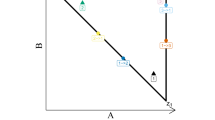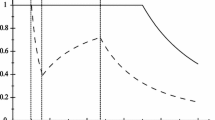Abstract
Two alternative models of legislative outcomes are the minimum winning coalition and the competitive equilibrium (Koford, 1982). In a unidimensional setting, the outcome under the former is the median, while the outcome under the latter is the highest net demand location.
This paper describes the competitive equilibrium in a unidimensional model, and shows that under some common conditions it coincides with the median, in particular for pure redistributive issues. However, for distributive issues, the two equilibria will differ. Finally, the comparative statics of the two models are examined; while the winning coalition is sensitive only to changes in the location of the median, for “distributive” issues the competitive equilibrium has the standard “economic” comparative statics that the outcome adjusts in the direction of the change in preferences.
Similar content being viewed by others
References
Baumol, W.J., Panzar, J.C. and Willig, R.D. (1982).Contestable markets and the theory of industry structure. New York: Harcourt, Brace Jovanovich.
Becker, G.S. (1983). A theory of competition among pressure groups for political influence.Quarterly Journal of Economics 98 (August): 371–400.
Black, D. 1958.The theory of committees and elections. Cambridge: Cambridge University Press.
Buchanan, J.M. and Tullock, G. (1962).The calculus of consent. Ann Arbor: University of Michigan Press.
Coleman, J.S. (1966). The possibility of a social welfare function.American Economic Review 56 (December): 1105–1122.
Coleman, J.S. (1973).The mathematics of collective action. Chicago: Aldine.
Cornes, R. and Sandler, T. (1986).The theory of externalities, public goods, and club goods. Cambridge: Cambridge University Press.
Coughlin, P. and Nitzan, S. (1981). Electoral outcomes with probabilistic voting and Nash social welfare maxima.Journal of Public Economics 15: 113–121.
Demsetz, H. (1968). Why Regulate Utilities?Journal of Law and Economics 11 (April): 55–66.
Enelow, J. and Hinich, M.J. (1984).The spatial theory of voting: An introduction. Cambridge: Cambridge University Press.
Gilmour, J.B. (1989). Hardball and softball politics: A theory of coalition size in congress. Political economy working paper #134, Washington University, May.
Greenhut, M.L., Norman, G. and Hung, C-S. (1987).The economics of imperfect competition: A spatial approach. Cambridge: Cambridge University Press.
Hinich, M.J. (1977). Equilibrium in spatial voting: The median voter result is an artifact.Journal of Economic Theory 16: 208–219.
Hinich, M.J. (1978). The mean versus the median in spatial voting games. In P.C. Ordeshook (Ed.),Game theory and political science. New York: New York University Press.
Koford, K. (1982). Centralized vote trading.Public Choice 39: 245–268.
Koford, K. (1986). Equilibrium and optimality in centralized vote-trading. Unpublished, January.
Koford, K. (1987). Scale economies and rent-seeking in legislative parties.Public Choice 52: 35–55.
Koford, K. (1989). Different preferences, different politics: A demand-and-structure explanation.Western Political Quarterly 42 (March): 9–31.
Lancaster, K.J. (1979).Variety, equity, and efficiency. New York: Columbia University Press.
Lowi, T. (1964). American business, public policy, case studies and political theory.World Politics 16: 677–715.
Mueller, D.C. (1973). Constitutional democracy and social welfare.Quarterly Journal of Economics 87 (February): 60–80.
Mueller, D.C. (1979).Public Choice. Cambridge: Cambridge University Press.
Poole, K.T. and Rosenthal, H. (1985a). A spatial model for legislative roll call analysis.American Journal of Political Science 29 (May): 357–384.
Poole, K.T. and Rosenthal, H. (1985b). The unidimensional Congress: 1919–1984. Paper presented at the American Political Science Association annual meetings, August.
Rasmusen, E. (1989).Games and information: An introduction to game theory. Oxford: Basil Blackwell.
Riker, W.H. (1962).The theory of political coalitions. New Haven: Yale University Press.
Riley, J.G. (1979). Informational equilibrium.Econometrica 47: 331–359.
Salop, S.C. (1979). Monopolistic competition with outside goods.Bell Journal of Economics 10: 141–156.
Thompson, F. (1979). American legislative decision making and the size principle.American Political Science Review 73 (December): 1100–1108.
Tirole, J. (1988).The theory of industrial organization. Cambridge, MA: MIT Press.
Weingast, B.R. (1979). A rational choice perspective on congressional norms.American Journal of Political Science 23 (May): 245–263.
Weingast, B.R., Shepsle, K.A. and Johnsen, C. (1981). The political economy of benefits and costs: A neoclassical approach to distributive politics.Journal of Political Economy 89 (August): 642–664.
Wilson, C. (1980). The nature of equilibrium in markets with adverse selection.Bell Journal of Economics 11 (Spring): 108–130.
Author information
Authors and Affiliations
Rights and permissions
About this article
Cite this article
Koford, K. The median and the competitive equilibrium in one dimension. Public Choice 76, 273–288 (1993). https://doi.org/10.1007/BF01049325
Accepted:
Issue Date:
DOI: https://doi.org/10.1007/BF01049325




